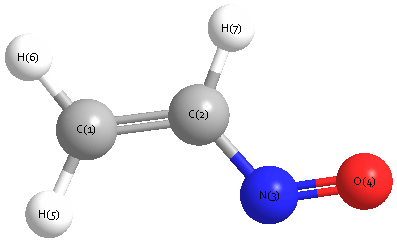Vibrational Frequencies calculated at HF/CEP-31G
| Mode Number |
Symmetry |
Frequency
(cm-1) |
Scaled Frequency
(cm-1) |
IR Intensities
(km mol-1) |
Raman Act
(Å4/u) |
Dep P |
Dep U |
|---|
| 1 |
A' |
3476 |
3133 |
16.32 |
66.80 |
0.67 |
0.80 |
| 2 |
A' |
3410 |
3074 |
9.20 |
103.25 |
0.35 |
0.52 |
| 3 |
A' |
3367 |
3035 |
5.74 |
63.20 |
0.19 |
0.32 |
| 4 |
A' |
1824 |
1644 |
7.42 |
146.43 |
0.21 |
0.35 |
| 5 |
A' |
1740 |
1569 |
175.77 |
134.32 |
0.33 |
0.49 |
| 6 |
A' |
1546 |
1394 |
16.92 |
33.86 |
0.42 |
0.59 |
| 7 |
A' |
1399 |
1261 |
5.41 |
17.57 |
0.38 |
0.55 |
| 8 |
A' |
1268 |
1143 |
61.81 |
45.57 |
0.56 |
0.72 |
| 9 |
A' |
989 |
891 |
22.19 |
1.73 |
0.73 |
0.85 |
| 10 |
A' |
643 |
579 |
8.83 |
8.56 |
0.33 |
0.50 |
| 11 |
A' |
371 |
335 |
2.12 |
0.61 |
0.75 |
0.86 |
| 12 |
A" |
1152 |
1039 |
49.17 |
16.37 |
0.75 |
0.86 |
| 13 |
A" |
1091 |
984 |
52.29 |
5.68 |
0.75 |
0.86 |
| 14 |
A" |
749 |
675 |
2.50 |
7.03 |
0.75 |
0.86 |
| 15 |
A" |
194 |
175 |
0.10 |
0.78 |
0.75 |
0.86 |
Unscaled Zero Point Vibrational Energy (zpe) 11609.3 cm
-1
Scaled (by 0.9014) Zero Point Vibrational Energy (zpe) 10464.6 cm
-1
See section
III.C.1 List or set vibrational scaling factors
to change the scale factors used here.
See section
III.C.2
Calculate a vibrational scaling factor for a given set of molecules
to determine the least squares best scaling factor.
Charges, Dipole, Quadrupole and Polarizability
Charges from optimized geometry at HF/CEP-31G
Charges (e)
| Number |
Element |
Mulliken |
CHELPG |
AIM |
ESP |
| 1 |
C |
-0.336 |
|
|
|
| 2 |
C |
-0.113 |
|
|
|
| 3 |
N |
0.061 |
|
|
|
| 4 |
O |
-0.242 |
|
|
|
| 5 |
H |
0.194 |
|
|
|
| 6 |
H |
0.179 |
|
|
|
| 7 |
H |
0.257 |
|
|
|
Electric dipole moments
Electric dipole components in Debye
(What's a Debye? See section
VII.A.3)
| |
x |
y |
z |
Total |
| |
1.858 |
3.689 |
0.000 |
4.130 |
| CHELPG |
|
|
|
|
| AIM |
|
|
|
|
| ESP |
|
|
|
|
Electric Quadrupole moment
Quadrupole components in D Å
| Primitive |
|---|
| | x | y | z |
|---|
| x |
-23.167 |
-0.629 |
0.000 |
| y |
-0.629 |
-24.280 |
0.000 |
| z |
0.000 |
0.000 |
-24.239 |
|
| Traceless |
|---|
| | x | y | z |
|---|
| x |
1.092 |
-0.629 |
0.000 |
| y |
-0.629 |
-0.576 |
0.000 |
| z |
0.000 |
0.000 |
-0.516 |
|
| Polar |
|---|
| 3z2-r2 | -1.032 |
|---|
| x2-y2 | 1.113 |
|---|
| xy | -0.629 |
|---|
| xz | 0.000 |
|---|
| yz | 0.000 |
|---|
|
Polarizabilities
Components of the polarizability tensor.
Units are
Å
3 (Angstrom cubed)
Change units.
| |
x |
y |
z |
| x |
6.999 |
2.841 |
0.000 |
| y |
2.841 |
5.304 |
0.000 |
| z |
0.000 |
0.000 |
2.068 |
<r2> (average value of r
2) Å
2
| <r2> |
63.917 |
| (<r2>)1/2 |
7.995 |
